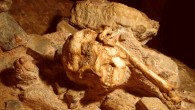An international team of archaeologists found that the Neanderthals who occupied Gruta da Figueira Brava in the Arrábida range, Portugal, between 86,000 and 106,000 years ago ate mollusks, crabs, fish, and even dolphins and seals. Homo neanderthalensis by Charles R. Knight. Excavating at Figueira Brava, University of Barcelona’s Professor João Zilhão and colleagues unearthed shell middens rich in the remains of mollusks, crabs, fish as well as...



















